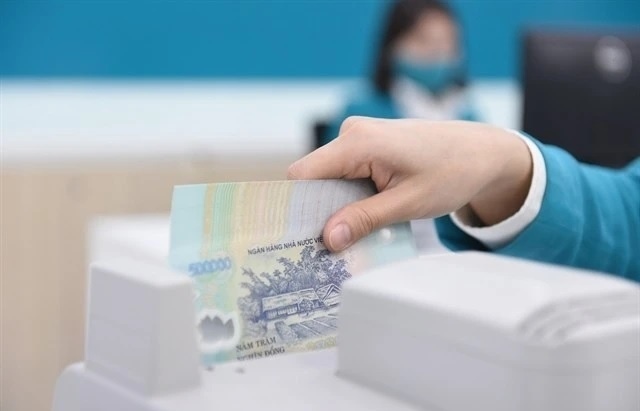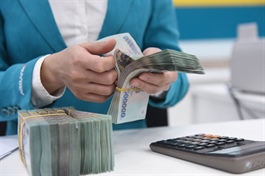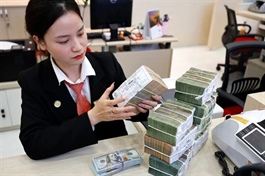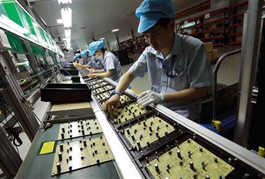Lofty GDP potential is indicator for credit demand
Lofty GDP potential is indicator for credit demand
The State Bank of Vietnam targets 16 per cent credit growth, but this may have to be higher if GDP hits the 10 per cent mark this year.
Vietnam’s central bank made the credit growth target to support 8 per cent economic expansion for 2025, but if growth reaches 10 per cent, credit must increase to 18-20 per cent, placing significant pressure on monetary and credit policies.

Lofty GDP potential is indicator for credit demand, (Photo courtesy of ABBANK) |
The government is aiming for 8 per cent GDP growth while accepting a moderate inflation risk of around 4.5 per cent. Additionally, a fiscal deficit of 3.6 per cent signals a strong commitment to accelerating public investment disbursement and reducing taxes, underscoring the robust economic growth target for 2025.
This also serves as a positive indicator for credit demand, as market expectations point to improved investment, production expansion, and consumer spending.
Pham Hong Hai, CEO of OCB, told VIR, “The economic landscape reveals multiple bright spots, including the government’s reform efforts, accelerated public initiatives, and the resolution of legal bottlenecks in real estate. These developments, coupled with improved consumer confidence, will drive economic growth and provide a strong foundation for the banking sector in 2025.”
“While non-essential spending has bottomed out and is gradually improving at a slow pace, supported in part by fiscal policies such as VAT reductions and lower vehicle registration fees, disposable income growth remains subdued.”
Nevertheless, banking executives remain optimistic about short-term credit demand from listed enterprises, driven by real estate firms’ debt restructuring needs and working capital requirements of other manufacturers. Meanwhile, medium- to long-term credit demand is expected to rise as lending rates decline, facilitating capital access for business expansion.
Tran Thi Khanh Hien, director of Research at MB Securities, forecasts 16 per cent credit growth in 2025, underpinned by two key factors.
“Firstly, Vietnam’s strong economic recovery in 2025, fuelled by improved manufacturing and trade activities amid rising domestic and external demand, will enable the State Bank of Vietnam (SBV) to maintain an accommodative monetary policy,” Hien said. “Secondly, high public investment disbursement will create new jobs and bolster credit demand, aligning with Vietnam’s economic recovery goals and large-scale infrastructure development initiatives.”
Economist Dr. Nguyen Tri Hieu predicts that while the SBV will maintain a flexible easing approach to stimulate growth, it is unlikely to adjust key policy rates such as the refinancing and discount rates.
“Instead, it will fine-tune open market operations to regulate exchange rates and liquidity. I anticipate a slight increase in lending rates, around 50 basis points, as economic activities regain momentum. However, this will have minimal impact on credit demand,” Hieu said.
Phan Duy Hung, director and senior analyst at VIS Rating, expects the average return on assets to inch up to 1.6 per cent in 2025 from 1.55 per cent in 2024, alongside credit growth of 15-16 per cent.
“Stronger demand for long-term corporate and mortgage loans will help banks offset high funding costs and expand net interest margins by 5-10 basis points to 3.5 per cent. Credit costs for state-owned and major banks will decline as asset quality improves,” Hung said.
Standing Deputy Governor of the SBV, Dao Minh Tu, emphasised the crucial role of capital in driving economic growth. “To achieve economic expansion, investment is essential, and investment requires adequate capital supply,” he said.
“A GDP growth target of over 8 per cent, potentially reaching 10 per cent, is highly ambitious and presents a significant challenge. GDP growth of nearly 7 per cent in 2023 corresponded with 14.55 per cent credit growth, while 7.09 per cent GDP growth in 2024 was accompanied by 15.08 per cent credit expansion. In other words, every additional 2 per cent in credit growth supports approximately 1 per cent GDP growth.”
According to Tu, at the end of 2023, total outstanding loans stood at $558.3 billion, rising to $645.8 billion in 2024, injecting $87.5 billion into the economy. In 2024, total lending volume reached $958.3 billion, with debt repayments of $875 billion, contributing to 7.09 per cent GDP growth. “For 2025, the SBV has set a 16 per cent credit growth target to support 8 per cent GDP growth. Should GDP expansion reach 10 per cent, credit growth would need to be in the 18-20 per cent range,” Tu said.
A key challenge remains securing sufficient capital to sustain economic growth, especially given ongoing weaknesses in medium- to long-term capital mobilisation channels such as the stock market and corporate bonds. Consequently, bank credit remains a crucial funding source.
According to Tu, the SBV’s monetary policy will prioritise inflation control, currency stability, and macroeconomic balance while actively supporting economic growth. “Policy implementation this year will be flexible, prudent, and coordinated with fiscal policy and other macroeconomic measures, including trade and import-export policies,” he added.
“These are the broad principles guiding monetary policy. More specifically, ensuring sufficient liquidity for the economy and commercial banks is paramount. If capital is required to meet investment needs, the SBV will deploy appropriate policy tools, including refinancing and open market operations, to facilitate capital flows,” Tu said.
Economic expert Dr. Le Xuan Nghia cautioned that Vietnam’s financial system remains overly reliant on bank credit, posing potential risks. “Economic growth is influenced by multiple factors beyond monetary expansion. A sustainable economy cannot rely solely on bank credit; a more comprehensive and balanced financial market is essential. Addressing challenges in the corporate bond market will be crucial in reducing the long-term funding burden on the banking system,” Nghia said.


























